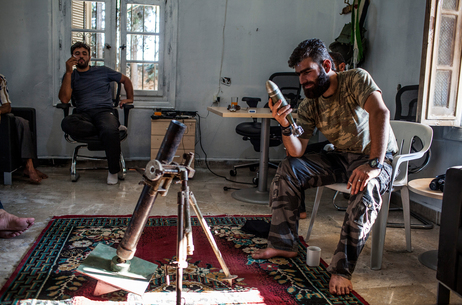Syria Feature: Insurgents Fighting With A Hodge-Podge of Weapons (Chivers)
 Photo: Bryan Denton/New York TimesC.J. Chivers reports for The New York Times:
Photo: Bryan Denton/New York TimesC.J. Chivers reports for The New York Times:
As the midsummer sun blazed over this partially deserted Syrian city one recent afternoon, two young men appeared in a pickup truck in an alley near several auto repair workshops. Protruding from the truck’s bed was a steel pipe about three feet long and two and a half inches wide, resting on a simple frame.
The pipe was not for plumbing. It was a locally made mortar that had been used in July in the battle for Azaz, a city in northern Syria where antigovernment fighters drove away the army of President Bashar al-Assad.
“Now we have three or four of these, but we need to make more,” said Mustafa, one of the men who had assembled the weapons in small machine shops where since last year a key aspect of the revolution against Syria’s government has been waged by men who do not themselves often carry guns.
Mustafa’s handiwork, which also includes the manufacture of homemade mortar rounds (“We can make, every day, 25 shells,” he said), is part of a grass-roots effort to create the fighters’ diverse and idiosyncratic arsenal. That is an essential component of the rebels’ survival and their recent successes against the professionally trained military with which they are locked in a struggle for Syria’s future.
Working together and at the urging of antigovernment fighters, local businesses and tradesmen have organized into a network engaged in making weapons, in part by delegating different tasks among the various trades. Some shops concoct explosives and propellants, a job that one organizer, Ahmed Turki, said had best been accomplished by a local painter with experience mixing chemicals. Others, who have electricians’ skills, wire together the circuits for makeshift bombs.
Machinists and metallurgists assemble rockets and mortars, as well as the bodies for mortar and artillery shells or the large cylinders often used to hold the charges in roadside or truck bombs. (These men also manufacture truck mounts for machine guns captured from government forces; one novel design included using a disc brake from a motorcycle to arrest the movement of the weapon as its operator adjusts the gun’s elevation.)
Still others remove the propellant from captured tank and artillery rounds, which is then repurposed in the rebels’ arms.
As the forces opposed to Mr. Assad have appealed with little success to the West for weapons and foreign air support, the rebels have steadily pursued their own project, developing the dark arts of weapon-making with surprising speed.
In many ways, the weapons gathered by the uprising here resemble those seen in the insurgencies fought against Western forces by Iraqis, or against Israel by Palestinians. This is in part, participants in the effort said, because they were able to model their weapons on those used in other Middle Eastern uprisings.
“We copied original Palestinian rockets,” said Mr. Turki, who has since designed seven different styles of midrange explosive rockets. He also drew up plans for a rear-loading, 62-millimeter towed artillery piece that is in development and that was displayed, between tests, to two journalists from The New York Times.
Mixing arms captured from their enemies with arms smuggled across borders, and adding in weapons that the rebels’ supporters have made in a constellation of hidden shops, Syria’s guerrilla brigades have managed to drive the conventionally equipped Syrian armed forces from areas of the northern countryside and, in certain areas, to put the government to siege.
This shadowy industry — resourceful and effective, but also dangerous — serves as more than a source of supply. It is also an indicator of both the rebels’ local organization and their near absence of outside logistical support.
 Ahmed Turki,
Ahmed Turki,  C.J. Chivers,
C.J. Chivers,  New York Times,
New York Times,  Syria
Syria 
Reader Comments